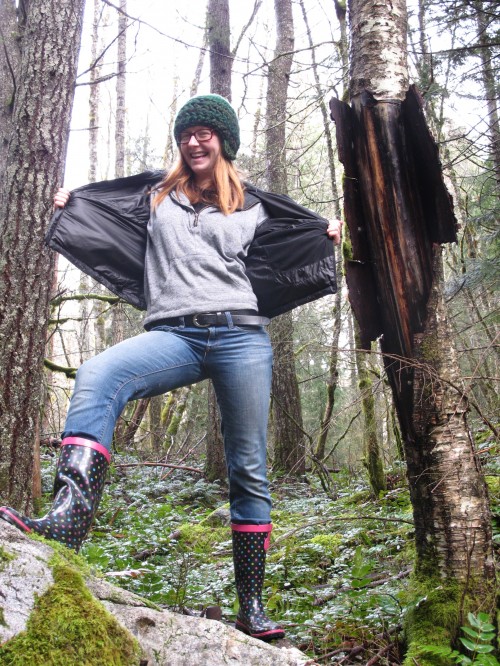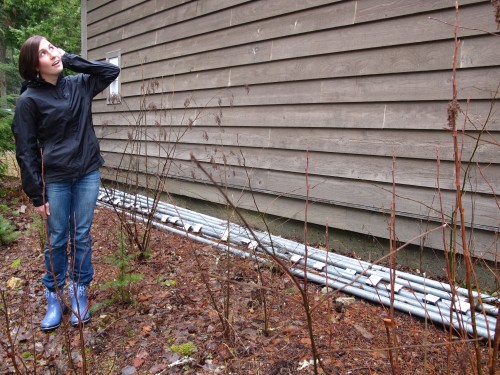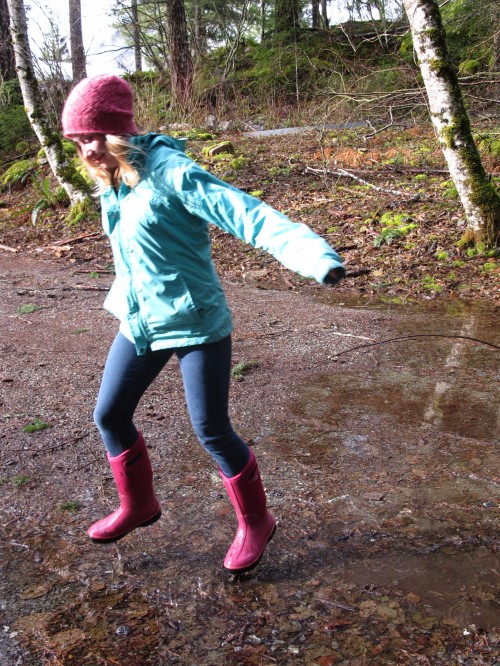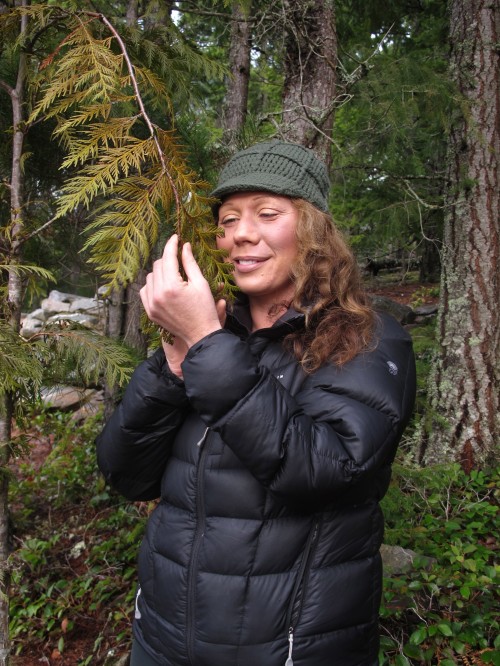Late Morning, Rainy, Wabi-Sabi Writing

How often are you given the task to slowly, silently develop your awareness of beauty? Even more rare, perhaps, to be mindful of this tempting trait as it resides the incomplete, imperfect, and impermanent nature of, well, everything? And to think about how you fit in, just maybe, to this struggle, this destruction, this temporality? The eight members of the North Cascades Institute’s Graduate M.Ed. Program (a.k.a. “Cohort 13”) were recently privileged to be assigned such a “wabi-sabi” meditation — an appropriate request considering we live in a national park full of obvious beauty, are in a contractual agreement with the gods of the Masters degree to be writing all the time and are trained professionals in landscape observation. Additionally, we were graced by a day of instruction from Tele Aadsen, our writer-in-residence, neighbor and occasional Chattermarks contributor. She handed us our wabi-sabi writing prompt on yellow slips of paper, and unleashed us upon the rainy trails. Varied and place-based, we thought you might enjoy this sampling of what we came up with. —Katherine Renz
By Katie Komorowski
The trees, they are not perfect. They don’t all stand up straight in rows. Their branches aren’t all equidistant or hold the same number of leaves. They bear scars just like us. Take the one who’s tattooed, carved into with the initials, “MT ‘hearts’ ST”. I wonder if they are still together? Their mark is. Dug into this alder and scarred over, proof that trees are not pure but tough.
Or how about that tree that looks like a flasher whipping open their trench coat to expose their goods? Bark folded out like the cover of a book, nearly square and so unnatural. It screams of wildness and reeks of desperation.
And what of that mottled, old Doug Fir? Thick bark that used to be almost chocolate colored, now flecked in white lichen, with moss growing on it like a shaggy beard. So aged, so dignified in its mossy, lichen mess; this tree wears it like a disguise, camouflage to blend in with the lighter trees around it.
These imperfections breathe character into the woods. Each one so different than the last, though to a passerby they’d appear the same. Only when I stop to look and really see each one do I get a glimpse at the story. How is this tree’s life different than that one’s? Neighbors though they may be, each one carries a strong identity.
By Sarah Stephens
 Graduate student and musician, Sarah Stephens, listens to an unlikely orchestra.
Graduate student and musician, Sarah Stephens, listens to an unlikely orchestra.
I sit between the compost shelter and the maintenance shed, orchestra seating. The sky is a gray curtain. Members of the ensemble race toward the main stage. By the time I arrive the concert has already started. A steady pat pat pat pat of drips fall softly onto decayed leaves, fixing the rhythm. Just below the edge of the roof lay a pile of six long pipes; the stage is set.
The musicians take turns cascading off the roof to play their single note before rolling along the pipe to begin rehearsal for their next performance. Dozens sound at a time — plip plip tt tt plip plip tt tt, ding, din din ding, din din, ta, ting ting ting ting ta, ting ting ting ting: a metallic medley. It’s a light and celebratory piece played for the majority of this venue’s season. I’ve come right in the middle. Thought it would be a good way to start the new year.
I went looking for humble
By Kaci Darsow
I went looking for humble.
“Don’t write about the fancy things,”
She had said.
I walked and walked
Listening to the raindrops tick against fallen leaves.
Everything felt humble in this weather.
I could look closely, write mindfully
On any of these things.
The drooping sword ferns
The moss covered, dripping branches of Maple
The frozen slush on the log, battered by rain
The shadow of a snag,
Its rotten bole fallen away, laying before it
An empty sheath of bark still standing.
There was a quiet, resilient beauty to it all.
But the closer I looked, the more I understood,
All these things were incredibly grand.
An obvious, striking, remarkable beauty
Filling important roles in the community,
Their existence supporting the survival of it all.
These were not the impermanent, imperfect or incomplete.
They were the essential beings.
Not simple, overlooked or rejected,
The sought out, the celebrated, the infinitely complex.
I walked on.
The steep trail, my many layers
The cold air
Making my breathing heavily labored.
Drops of moisture ran down my face
Into the corners of my eyes.
I couldn’t tell if they were sweat or rain.
They tasted like both.
Finally, I found a dry patch of trail
Under a Hemlock and Doug Fir.
I sat down to scribble away
But was stopped
By the large drops landing on my page.
I looked up,
But none fell on my face.
I looked down,
Three more large drops splattered my ink.
My hair was dripping with sweat
And probably rain too, as I forgot my hood.
As I returned to write
A thought flashed through my mind.
Is this what I need to be writing?
These are words on a page,
Written by my pen.
Yes.
Most certainly yes.
A simple start
An Hour in the Rain
By Tyler Chisholm
I came here to write about mountains. But today you can’t see the mountains.
There are hints of them, giant boulders amid a river of clouds. I watch as fluid clouds flow between rock mounds, briefly forming patterns before destroying them as they move gracefully down valley. The weather is indecisive today, fluctuating between misty rain, heavy rain, and even a wintery mixture of slushy bombs pelting the ground with something not quite snow-like. As I walk down the trail on a “wabi-sabi walk’, as the writing folks call it, searching for inspiration (since the mountains are too elusive to cooperate), my mind embodies the indecisiveness of the weather. I see inspiration in every leaf, stump, stream, and moss-covered tree. My mind becomes a running dialogue, flowing like the river of clouds, then switching abruptly to a new topic, just as the rain. The wabi-sabi continues like this, with every turn of the path discovering new subjects until I finally turn back, slightly discouraged.
It is only then that I truly accomplish the goal of the wabi-sabi: I observe for the sake of observing. Heading back down to my cozy apartment, splashing through slushy puddles in my bright pink rain boots, I realize my indecisiveness is not due to a lack of inspiration, but due to an over-stimulation of motivation.
 Pink rain boots ready, Tyler Chisholm demonstrates her inspiration AND motivation at the first available puddle.
Pink rain boots ready, Tyler Chisholm demonstrates her inspiration AND motivation at the first available puddle.
Lakeside Landing
By Elissa Kobrin
I picked a bad spot, oh man, this is the worst possible spot. But I landed here and I liked the look of the lake. It was so hard to take root: many rocks, not much duff, but there was plenty of water, and we Western redcedars love water. Every moment was a struggle – too much sun! I had to stretch and bend to get cool in the sparse shade on very hot days.
At ten years old, I’m not looking very good. I see my reflection taunting me from the surface of the water. I look skinny and spindly. My bark looks more like an alder than a cedar, bare and pale. . .so very naked in spots beaten by wind and sun. My needles are so sparse, clustered in goofy bunches at my feet with a sickly yellowing crown at my head. Not enough nutrients here, not enough shade.
The lodgepole pines have done their best to help with encouragement. One leaned over to grow between me and the most open angle of the relentless summer sun. Not one other of my kind is here, having found deep shade and soft soil up the trail toward the mountain. The Douglas firs and the lodgepoles love it here. So many babies growing robust and green! But I am sick, yellow and thin. I will not live 500 years like my mother or grow tall and deep green like my father. I will survive here as long as I can, because I do love the look of the lake.
 Elissa Kobrin examines the yellowing needles of her new friend, a Western redcedar, still hangin’ in there on the shore of Lake Diablo.
Elissa Kobrin examines the yellowing needles of her new friend, a Western redcedar, still hangin’ in there on the shore of Lake Diablo.
Leading photo: Katie Komorowski imitates the “flasher” paper birch she found to be so wild and desperate along the Deer Creek Trail.
All photos by Katherine Renz.
Cohort 13 is currently experiencing a rather mild North Cascades winter while in residency at the Environmental Learning Center. When not in class, they’re out exploring, creating non-profit organizations, and wabi-sabi-ing their way toward changing the world.


Aw, buddies… You were all so good! Wait – we talked about how not-helpful that is as feedback (“good,” “I liked it!”) so let me rephrase that. You approached your paper and our whole day with such willing, participatory energy. I so appreciated that ALL of you chose to share your writing, how thoughtfully you responded to each other, & how exciting it was to hear everyone’s different voices & impressions of the same setting. Thanks for making my first teaching experience so good; truly a pleasure to share the day with you.